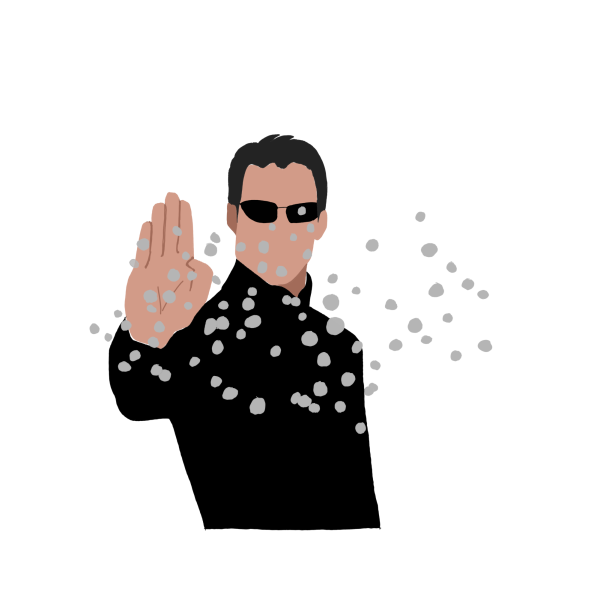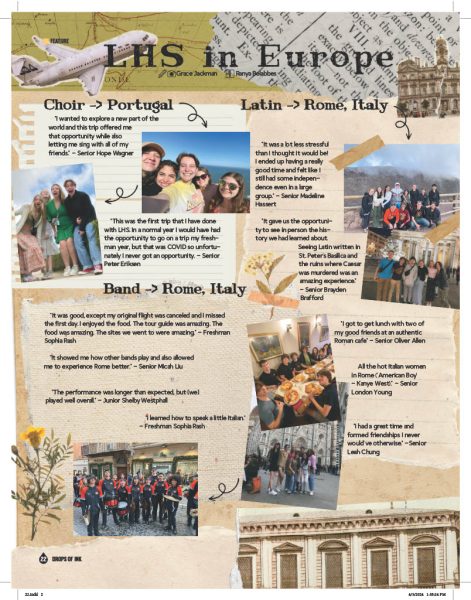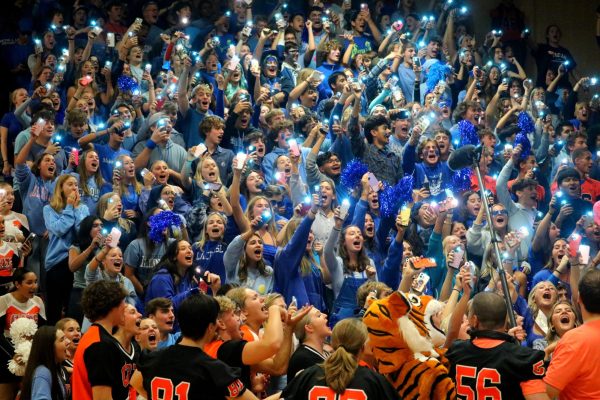Horror Movie Starter Pack

As shown above, the numerous tropes of horror movies vary greatly, creating a uniquely diverse group of characters, which begs to answer the question of which horror movie would be complete without them.
From final girls like Laurie Strode and Nancy Thompson, to the villains themselves such as Jason Voorhees and Chucky, horror history is packed full of popular tropes and stereotypes. Without further ado, I present to you the outstanding tropes of horror movies. A spoiler alert is hereby in effect for the Halloween franchise, the Scream series, the Friday the 13th movies, the Final Destination saga, Stranger Things, The Mist and The Cabin In the Woods.
The Immortal Villain
Ah, yes. The immortal villain. No horror movie would be complete without one of these lumbering menaces. They take on different forms, from killer dolls, to clowns, to hillbilly cannibals, but all share similar goals of carnage, violence, and terror. Usually, the killer possesses some form of superhuman durability. One classic example is Michael Myers. In the 1978 classic Halloween, this sororicide-loving villain survives being shot multiple times by his former psychiatrist Dr. Loomis and falling from a balcony. With the addition of 2018’s Halloween and its 2021 sequel Halloween Kills, Myers survives numerous fatal injuries, including being shot, stabbed and beaten by an angry mob led by former victim Tommy Doyle. Ultimately, while it can get a little tiring to watch the big bads survive attempt after attempt on their lives, they’re still a very entertaining trope, and no horror franchise would be complete without them.
The Mortal Villain
A subversion of the previous entry, this much more simple, yet rare villain is one that can actually be vanquished for good. This, in turn, gives our characters a truly celebratory ending. One example is Ghostface, the moniker given to the numerous villains throughout the Scream franchise. The movies have proven wildly successful, with the sixth installment being released this upcoming March. Unlike the hulking shapes of Michael and Jason, Ghostface is always little more than a person in a costume. True, he or she is a dangerous threat and claims several victims by the movie’s end, but you can always count on the man or woman behind the mask ultimately failing in the end. It’s also always interesting to see real humans with motives serve as the villains, rather than, say, Freddy Krueger, who kills simply because he can. While the killer always comes back for one last scare, they’re not quite as hard to defeat as other villains. And of course, the survivors of the movie’s big bad are always led by the next trope on the list: the final girl.
The Final Girl
The final girl is a time-honored tradition in horror movies. Many movies feature a young group of teens, eager to engage in the indulgences of life, quickly getting dispatched one by one by the killer(s). The final girl is the exception. Unlike her friends, who are often unlikable and prone to making poor decisions, the final girl keeps a relatively cool head throughout the movie, and usually engages in a showdown with the killer at the end. Here, her fate is ambiguous. Some, like Alice Hardy in the original Friday the 13th survive the events of the movie and even get in a good fight with the killer, only to prove unable to cheat death later on. Others, like some of the various heroines in the Final Destination series ultimately succumb to impossible odds despite their best efforts. Some, however, like Sidney Prescott of the Scream series, or Laurie Strode of the Halloween franchise, survive and live to fight another day. In some instances, years later, they even return to guide the next generation of potential victims in their fight against the villain.
The Cops
Let’s face it: the cops in horror movies are the most inaccurate career depiction of all time. There is no way that police officers could be this incompetent in real life. In the movies, it’s as though these officers graduated from kindergarten, were given a badge, and sent out to protect and serve. One example is Scream 4, wherein two officers of the Woodsboro Police Department are assigned to stake out a house occupied by potential targets of the new Ghostface killer. Rather than do their jobs correctly, they pass the time doing crossword puzzles and talking in a predatory manner about a high school girl. After an ill-timed prank, following a poor job of a perimeter check, both cops end up on the receiving end of a Ghostface attack. In horror movies, when the cops do show up, it’s often too late, or results in them getting easily dispatched by the villain, sometimes both. While some are a more accurate depiction, armed with lovable nature and resourcefulness, such as Dewey Riley in the Scream series, or Jim Hopper of Stranger Things, for the most part, we can establish that this is the worst trope to be a part of in a horror movie.
The Fool
Far from the connotations of the name, the Fool is arguably one of the most respectable tropes in a horror movie. Sure, they pass most of the time smoking various illegal substances and drinking more than their fair share of alcohol, but in the end, it’s often the Fool who provides the most comic relief, and even comes up with the smartest ideas to beat the killer. Like a modern iteration of a Shakespearean court jester, the fool is widely disregarded, but chock-full of wisdom and insight. One example comes in the film The Cabin In the Woods, a horror comedy about five teens who are secretly pawns in a global experiment to make a real-life horror movie. Marty, designated as the Fool of the group, spends most of the movie talking in a laid-back, stoner-esque voice, smoking from a telescopic bong that collapses into a thermos. However, Marty is the first to discover the signs of their surveillance and external factors, and ends up discovering the plot altogether, and working with final girl Dana to defeat it, ending up in the respectable position of one of the last two teenagers standing.
The Scholar
The Scream franchise provides perhaps the best example of this long-standing, dorky trope. Widely disregarded by many, similar to the fool, the scholar is often the member of the group who receives the most criticism, due to their sheltered, somewhat nerdy lifestyle. In the original Scream, Jamie Kennedy as Randy Meeks perfectly embodies this trope, commenting on the rules to surviving a horror movie, and surviving a gunshot from killer Billy Loomis. While he meets an unfortunate end in the sequel, his legacy lives on through a similar character, Robby Mercer, in Scream 4, and Randy’s niece Mindy Meeks-Martin in 2022’s Scream, who is smart enough to play dead following an attack by Ghostface, and survives the movie, being wheeled out on a stretcher among the carnage. The scholar at first receives critique from their acquaintances, and is never a full-fledged member of the group, but while the others are running around and getting picked off on the silver screen, the scholar is usually the smartest character, and often has a knack for staying alive in tight situations.
The Sage
The trope of the sage is one very similar to the scholar, with a few key differences. While the scholar is often a younger, teenage survivor, the sage is often an older character, sometimes even a legacy character from a previous installment. While the scholar is often smart in a charismatic, nerdy sort of way, the sage is often very wise, and often experienced with the threat at hand, being a staple trope in creature features and action movies as well. This trope is also unique because characters can transcend the genre by being other stereotypes as well as this one. For example, in the original Halloween, Laurie Strode serves the role of the final girl. Many years later, in the 2018 sequel, she has become a battle-hardened survivor, keeping an underground survival bunker in her house, becoming a skilled marksman, and setting traps for Michael Myers. The sage is often a toughened, grisled survivor, ready to see the new cast of characters to success, and sadly often meets their demise in a heroic blaze of glory, making them a very underappreciated trope.
The Unlikely Hero
The unlikely hero is often a character regarded with little attention, because of an exterior quality such as appearance, stature, or demeanor. However, they prove to be a formidable ally, or in some cases, prove to be virtually useless but sacrifice themselves for others. One example of this comes in the 2007 Stephen King adaptation The Mist. Following a group of survivors hunkered down in a supermarket during an onset of an opaque fog and Lovecraftian monsters, the store’s assistant manager Ollie Weeks proves to be a valuable asset, despite his mild-mannered nature and unassuming stature. A skilled sharpshooter, he bravely defends a group of survivors from giant spiders in a failed pharmacy run, shoots down the main human antagonist to help his friends escape, and dies after opening the doors to a getaway car, ensuring that despite his own death, his friends will live to fight another day. Bob Newby from Stranger Things, who dies to get his allies out of Hawkins Lab, and Kenny the cameraman from Scream, who is killed after giving Sidney Prescott shelter in the news van and trying to run back to the house to save another survivor, are other examples. The unlikely hero is often, as the name implies, very unassuming and easygoing. But when the pressure begins to double down and everybody else is cracking, their heroic side will ultimately come out.
The Champion
The champion is often a member of the friend group known for their extreme athletic skills and abilities. Often portrayed as a dumb, egotistical jock, there is more to them than meets the eye, as they often fend off against the killer in an amazing showdown. One example is Julius, from Friday the 13th Part VIII: Jason Takes Manhattan. After escaping a cruise ship, boxing prodigy Julius finds himself atop a building, confronted, with nowhere to go. Rather than try to flee or give up, he proceeds to box Jason across the rooftop, beating him with his bare fists to the brink of self-inflicted exhaustion. While he meets his end shortly thereafter, it is arguably the best scene in the running joke of a movie. The champion, despite seeming superficial or self-absorbent in the beginning, develops significantly as a character to earn a spot as one of the more self-respecting tropes.



![Senior Sam Foster, who plays the alto saxophone on the Jazz Lab Band, waves at the audience after their final piece. “[Jazz is] just something that I enjoy personally, and I wanted to do,” Foster said.](https://www.lhsdoi.com/wp-content/uploads/2024/04/USE4-600x400.jpg)


![For the final piece, a combination of Symphony Orchestra and Wind Ensemble played an extravagant song by Paul Hindemist. Flute soloist Dakota Olson had her moment highlighted within this song. “[My solo] was definitely challenging but it was fun too,” Olson said.](https://www.lhsdoi.com/wp-content/uploads/2024/03/amy-and-joey-shot-600x400.jpg)
![The Bel Canto choir, the junior choir, performs “Ex-Wives” from “SIX.” “We started [preparing], pretty much right after the Holiday concert,” junior Delaney Rybicki said. Caption by Ash Magalhaes](https://www.lhsdoi.com/wp-content/uploads/2024/02/IMG_7696-600x400.jpg)









